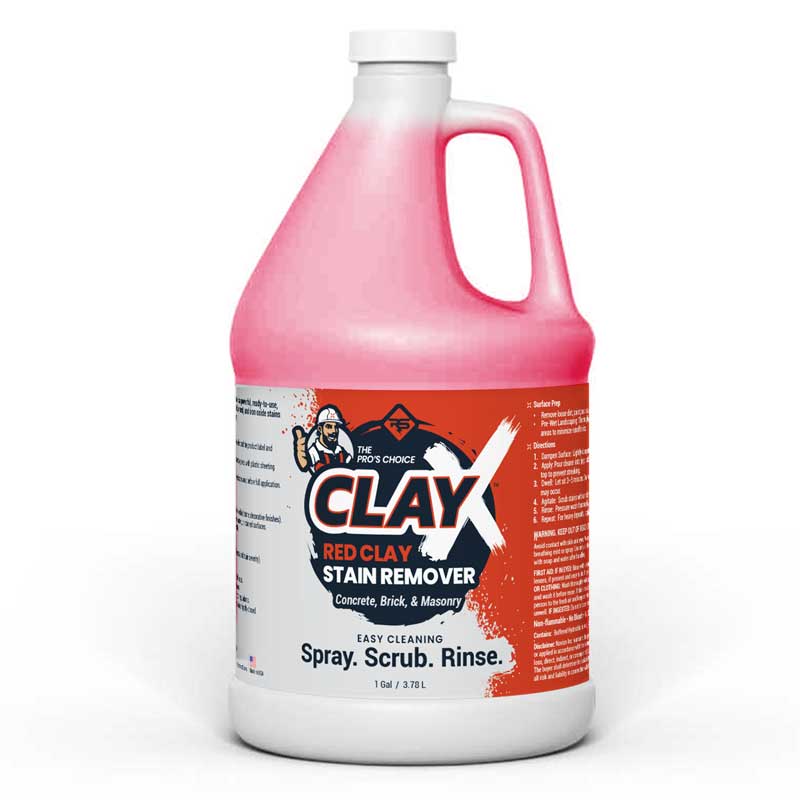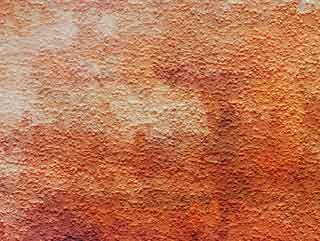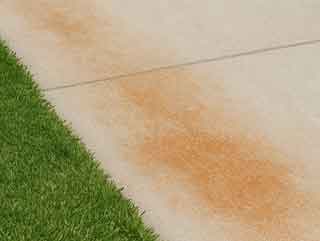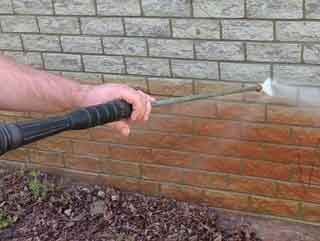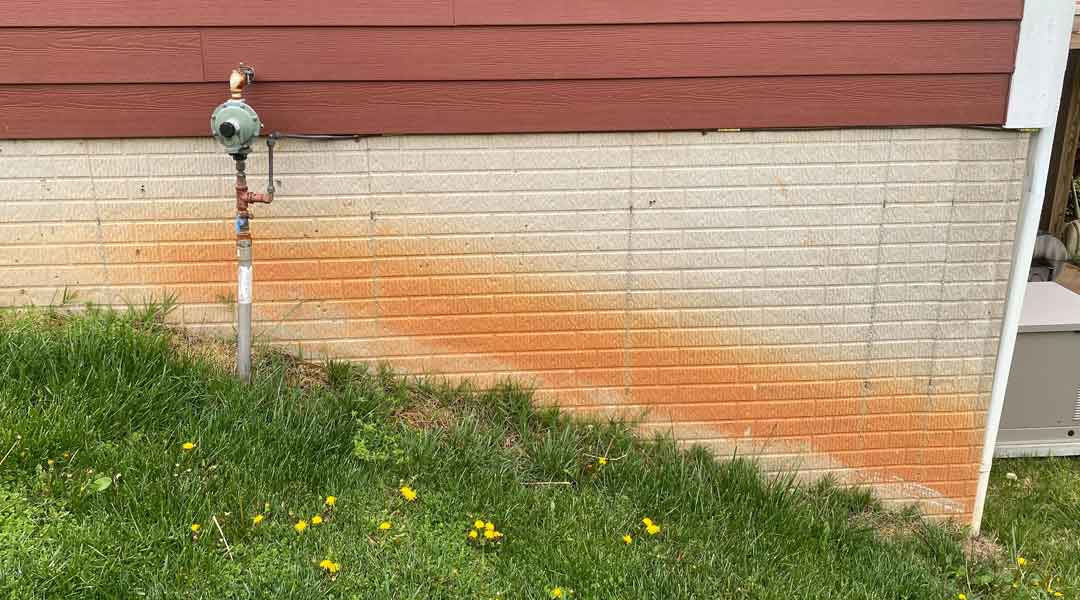
Understanding Red Clay Stains on Vertical Surfaces
If you live in the Southeastern U.S. or another clay-rich region, you’ve likely had to figure out how to remove red clay stains from walls made of brick, stucco, block, or stone. These vertical surfaces are especially vulnerable because of their porous structure and constant exposure to rain, splash-back, and irrigation runoff.
When iron-rich red clay splashes onto walls, it penetrates deep into the pores and dries into rust-colored streaks that ordinary cleaners can’t touch. Homeowners often find that pressure washing or household cleaners aren’t enough to deal with stubborn stains on masonry walls.
In this guide, we’ll explain why red clay clings so aggressively to vertical masonry, why common cleaning methods fall short, and how to remove red clay stains from walls effectively—without damaging the surface.
Why Red Clay Stains Are So Persistent on Walls
Walls made of brick, stucco, or concrete block are especially vulnerable to red clay stains. Their porous structure and high alkalinity allow moisture and minerals to penetrate deeply. When iron oxide (Fe₂O₃) from red clay splashes or runs down these surfaces, it bonds chemically with the masonry as the water evaporates — leaving behind stains that ordinary cleaners can’t remove.
Vertical surfaces, unlike flat ones, face constant splash-back and runoff from rain, sprinklers, and landscaping. This repeated exposure allows iron-rich clay to build up over time, creating dark, rust-colored streaks that require a specialized red clay stain remover for walls to eliminate.
💡 Did You Know?
In places like Georgia and the Carolinas, red clay soil can run hundreds of feet deep—making it a constant challenge for homeowners and contractors alike.
Why Common Cleaners Fail to Remove Red Clay Stains on Walls
Pressure washing may blast away surface dirt, but when it comes to red clay stains on walls, it often makes the problem worse. High-pressure water can drive iron oxide particles deeper into the pores of brick, stucco, or concrete block — making stains even harder to remove later.
Household products like bleach, soap, or degreasers? They simply aren’t designed to dissolve iron oxide (Fe₂O₃), the compound that causes red clay to bond with masonry. That’s why attempts to clean red clay off stucco, brick, or block walls with these products usually fail.
To truly remove red clay stains from walls, you need a specialized cleaner that breaks the iron oxide bond at the molecular level — without burning, whitening, or damaging the surface.
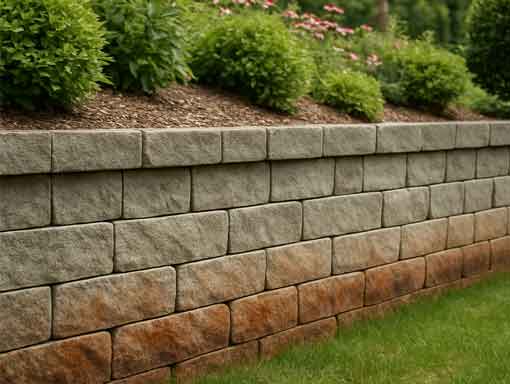
Red clay stains on retaining wall blocks are often challenging to remove.

Clay-X is the professional solution specifically designed to remove red clay.
Best Red Clay Stain Remover for Walls
Most generic cleaners don’t stand a chance against red clay stains on walls. They drip off vertical surfaces too quickly, lack the chemistry to dissolve iron oxide, and can even damage brick, stucco, or block. To truly remove red clay stains from walls, you need a cleaner built specifically for masonry.
What to Look for in a Masonry Cleaner
An effective red clay stain remover for brick walls, stucco, and concrete block should:
-
🧲 Cling to vertical surfaces long enough to break down embedded stains
-
🧪 Dissolve iron oxide (Fe₂O₃) at the chemical level
-
🧱 Be safe on masonry — including brick, stucco, concrete block, and stone
-
🚿 Rinse clean without burning, bleaching, or discoloring the surface
Why Clay-X Works on Brick, Stucco, and Block
Clay-X Red Clay Stain Remover is engineered specifically for vertical masonry walls. Its buffered acid formula delivers the cleaning power of an acid-based product — without the risks of raw acids.
-
Dissolves iron oxide bonds that cause red clay staining
-
Penetrates deep into porous stucco, brick, and block
-
Clings to vertical walls for longer contact time and better results
-
Rinses clean without whitening, etching, or surface damage
That’s why Clay-X is trusted as the best red clay stain remover for walls by homeowners, contractors, and property managers across the Southeast and other clay-heavy regions.
Clay-X Red Clay Stain Remover
Buy Direct
Why Clay-X Red Clay Stain Remover Works
Clay-X is not just another cleaner — it’s engineered specifically to remove red clay stains from walls made of brick, stucco, block, and stone. Unlike household products or raw acids, Clay-X uses a buffered acid formula that delivers the cleaning strength needed to dissolve iron oxide, but without the risk of burning, whitening, or damaging masonry.
What Is a Buffered Acid Formula?
Buffered acid means the chemistry is stabilized, giving you powerful cleaning action with controlled reactions. In plain terms: you get the strength of an acid cleaner without the harsh side effects that can ruin surfaces.
Why Clay-X Outperforms Generic Cleaners
-
Dissolves iron oxide (Fe₂O₃) at the chemical level, breaking the bond with masonry
-
Penetrates deep into porous surfaces like stucco, brick, and block
-
Clings to vertical walls to ensure longer contact time and better results
-
Rinses clean without etching, whitening, or harming the substrate
That’s why Clay-X is widely recognized as the best red clay stain remover for masonry walls — trusted by homeowners, contractors, and property managers across red clay regions.
Unlike off-the-shelf acids or bleach, Clay-X is purpose-built for iron oxide stains—removing the real source of red clay discoloration, not just the surface dirt.
🧽 How to Use Clay-X on Walls and Foundations
Red clay stains on walls can feel impossible to remove — until you use the right cleaner and method. Clay-X is built to cling to vertical masonry surfaces, dissolve iron oxide deposits, and rinse away clean. Here’s exactly how to use it to safely and effectively remove red clay stains from walls and foundations
Tools and Materials You’ll Need
Clay-X Red Clay Stain Remover (use undiluted)
Plastic hand-pump sprayer
Nylon bristle brush
Garden hose or pressure washer
Protective gear (gloves and goggles)
Step-by-Step Cleaning Process
- Protect your plants and landscaping. Before you begin, thoroughly soak nearby grass, shrubs, and flower beds with clean water. This helps prevent damage from overspray or runoff.
- Prep the wall. Lightly dampen the masonry surface with clean water. This improves absorption of Clay-X and extends wet dwell time. Avoid over-saturating — you want it damp, not dripping.
- Apply Clay-X undiluted. Pour directly into a clean plastic sprayer — no dilution needed. Apply evenly from the bottom up to prevent streaking and ensure full coverage on brick, stucco, or block walls.
- Let it work. Allow 3–5 minutes of dwell time. You may see light foaming or bubbling — a sign the formula is dissolving iron oxide. Do not let the product dry out; mist lightly with water if needed.
- Agitate stubborn areas. Use a nylon brush to scrub spots where red clay has built up. This helps break the bond between the stain and the masonry.
- Rinse thoroughly. Start from the top and work downward with a pressure washer for best results. The added force helps flush dissolved red clay particles from deep within the pores. If a pressure washer isn’t available, use a garden hose with a jet nozzle, though multiple passes may be required.
- Repeat if needed. Heavy or long-standing stains may require a second or even third application for complete removal.
💡 Pro Tip: Always test Clay-X on a small, hidden section first. This ensures compatibility and shows you how the product will perform on your specific wall surface.
✅ Best Vertical Surfaces for Clay-X
Clay-X is specially formulated to remove red clay stains from the types of vertical masonry surfaces most vulnerable to water runoff, splash-back, and soil exposure. Whether you’re a homeowner or managing a commercial property, it’s one of the best red clay removers for masonry walls — restoring curb appeal and protecting surfaces that are hardest to keep clean.
🏠 Residential Walls and Foundations
Clay-X is highly effective for homeowners struggling with red clay staining around the house, including:
-
Brick facades stained by irrigation overspray and muddy splash-up during heavy rains
-
Stucco siding — porous and alkaline, making it especially vulnerable to red clay stains
-
Concrete block foundation walls, where Clay-X is known as a top red clay stain remover for concrete block
-
Retaining walls positioned at soil level, where clay accumulates and dries into streaks
-
Stone veneer and decorative masonry fences that trap clay particles in textured surfaces
🏢 Commercial Walls and Structures
Contractors and property managers also rely on Clay-X to clean larger buildings and hard-to-maintain surfaces, such as:
-
Apartment and condo exteriors with stained entryways and foundations
-
Stucco or EIFS walls on shopping centers, hotels, and office buildings
-
CMU (concrete masonry unit) perimeter walls, common around schools, sports fields, and industrial sites
-
Retaining walls in business parks or campuses where irrigation runoff meets red soil
-
Monument signs, stone bases, and statues exposed to splash-back or erosion
LastiSeal • Flat
Buy Direct
Get It on Amazon
LastiSeal • Satin
Buy Direct
Get It on Amazon
🛡️ Protect Your Clean Walls with LastiSeal Sealer
Removing stains is only half the battle. Unless you seal the surface, rain, irrigation, and runoff will quickly bring back red clay stains on walls. Masonry like brick, stucco, and block is naturally porous — it soaks up water and iron-rich soil just as easily after cleaning as it did before.
That’s why sealing with LastiSeal is the smart next step. Think of it as insurance for your hard work: you clean once, then protect your walls for years.
Why Sealing Prevents Red Clay Stains from Returning
Every splash of rain or sprinkler overspray pushes minerals and clay into your walls. Unsealed masonry absorbs these contaminants, creating new stains. By penetrating deep inside the surface, LastiSeal forms a long-lasting barrier that blocks water, soil, and iron oxide from ever bonding again.
Benefits of Using LastiSeal on Vertical Masonry
-
🛡️ Stops new stains — repels red clay, rust, and water
-
🧱 Works on all vertical masonry — brick, block, stucco, and stone
-
🎨 Keeps the natural look — no film, gloss, or darkening
-
⏳ Long-term protection — lasts up to 15 years with one application
-
🏠 Ideal for homes and businesses — peace of mind for property owners
💡 Pro Tip: Wait 2–3 days after cleaning before applying LastiSeal to make sure the wall is completely dry. This ensures maximum penetration and performance.
Removing and Preventing Red Clay Stains on Walls
Red clay stains on walls aren’t just dirt — they’re the result of iron oxide bonding with porous masonry. That’s why pressure washing, bleach, or household cleaners can’t solve the problem.
Clay-X is built for this exact challenge. Its buffered acid formula safely and effectively dissolves iron oxide, making it the best way to remove red clay stains from walls made of brick, stucco, block, or stone.
But cleaning is only half the battle. To keep your walls looking fresh, seal them with LastiSeal Brick & Concrete Sealer. By penetrating deep below the surface, LastiSeal locks out water, soil, and clay — preventing stains from coming back.
👉 Clean with Clay-X. Seal once with LastiSeal. That’s the proven way to restore and protect your walls and foundations from red clay stains for years to come.
